performance space: the winning years
keith gallasch: fiona winning
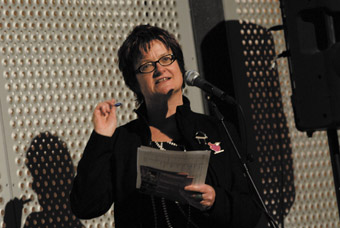
Fiona Winning opening Live Works
photo Heidrun Löhr
Fiona Winning opening Live Works
A WHITE LIMO WITH A MALE CHAPERONE IN A WHITE TUXEDO PICKS UP FIONA WINNING FROM HER HOME. THE CAR GLIDES TO THE OLD PERFORMANCE SPACE ON CLEVELAND STREET. WINNING ENTERS THE EMPTY THEATRE AND IS GUIDED TO THE DISTANT STAGE ON WHICH SITS A GLOWING CARDBOARD BOX WITH CURTAINS WHICH SHE OPENS AND AND PEERS IN. STILL IMAGES (FROM THE REPERTOIRE OF HEIDRUN LÖHR) AND SOUNDS OF PERFORMANCES ACROSS THE NINE YEARS OF HER CARING AND CREATIVE STEWARDSHIP AS PERFORMANCE SPACE DIRECTOR AT CLEVELAND STREET, AND THEN AT CARRIAGEWORKS, FLOW BY.
Winning watches the history she helped realise, so ephemeral, yet so palpable. She leaves by the rear exit and encounters colleague Billy Mac playing didjeridu in the park. At the nearby Bill & George’s artist-run space she’s entertained with a tango, and returned to the park where Martin del Amo dances in his underwear to Nana Mouskouri. And the night is still young.
Winning is driven to the back lane of the party venue, Medium Rare, an upstairs gallery in Redfern, where a red carpet awaits her and, when the carpet runs out, pieces of red cloth are thrown by the crowd to place beneath her feet. Inside she has to burst through a welcoming banner into an evening of more performances as well as laudatory speechmaking. The crowd comprises many members of Australia’s contemporary performance community, dancers, visual and media and sound artists, writers, past and present Performance Space Board members, Performance Space founder Mike Mullins and former director Sarah Miller, funding body colleagues and friends from Winning’s pre-PS days.
Victoria Spence is, as ever the ideal host. Billy Mac recalls Winning’s firmly propelling him into performance as an indolent young man and plays a didjeridu tribute to her. Annette Tesoriero leads a small ensemble in a sweet round of Viel Glück und viel Segen with the crowd joining in. A be-wigged PS associate director Bec Dean astonishes everyone with a wickedly funny, sexy karaoke rendering of “The Wind Beneath My Wings” for Winning. The PS staff dance to a pop tune with precision and abandon. Version 1.0 perform silently to a Jason Sweeney treatment of George Bush’s ‘economic recovery’ speech, sharing chocolate ice-cream, some with larger spoons and appetites than others, good manners verging on the very foul. Speeches from the board chair, Clare Petre, Sarah Miller, board member John Gillies and general manager Julianne Campbell celebrate Fiona Winning’s collaborative leadership and her capacities as nurturer, negotiator, promoter; as a PS director with the instincts of a producer, with a local and a national vision; as a delegator and a downright good boss—firm, fair, good-humoured, and explosive when necessary. She is praised in particular for her management of the transition to CarriageWorks. She’d left her notes at home but Winning makes an excellent speech in reply, vividly recalling the high points and challenges of her PS years and paying particular tribute to the many artists she worked with, to Julianne Campbell, and to Harley Stumm, her partner. This was a fitting farewell to be fondly remembered.
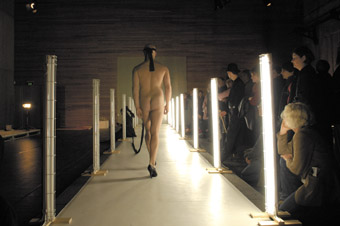
Dallas Della Force, Finale, The Pacitti Company, Live Works
photo Heidrun Löhr
Dallas Della Force, Finale, The Pacitti Company, Live Works
a kind of apotheosis: livework
s
The performance community in Sydney has long dreamt of a festival of performance, as had Fiona Winning even since the move to CarriageWorks. She made it a reality in the final months of her directorship if not without a struggle. The inaugural LiveWorks festival in September filled much of CarriageWorks with Winning’s vision: local, national, international, intergenerational and hybrid. Over two days (one with a deterring wintry downpour, the other fine, audiences flooding in) attendees looked to maps to find their way to diverse performances, competing for spaces to enjoy the intimate miracle of Aphids’ Underground (two virtuosic percussionists with us at a long table playing Rosemary Joy’s unlikely and subtly crafted instruments) or Duncan Speakman’s immersive Audio Walk through Redfern or Panther’s This is Not a Playground (we gather at a nearby playground and participate in games with a dark and metaphysical turn—a great idea if needing some serious tightening of text and concept).
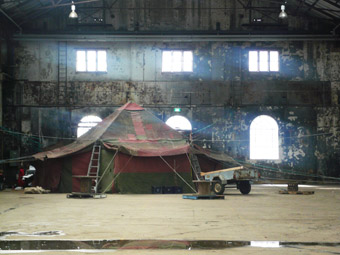
Tent, Matt Prest
photo Debra Jason
Tent, Matt Prest
In the massive, partly flooded, unrenovated Bay 23 there’s a car roaring away and a tent into which we file, to be fed soup and witness a strange encounter embellished by projections, puppets and other magic in Matthew Prest’s The Tent, an oddly compelling deadpan piece of Australian gothic about male relationships, among other things. Other local productions that impressed were Paul Dwyers’ Bougainville Photoplay Project Bougainville Photoplay Project and PACT Theatre’s The Speech Givers, which revealed a new level of inventiveness and intensity in Regina Heilmann’s direction, working with a cast of five instead of the usual mass of young PACT players. Jane Grimely, Gideon Payten-Griffiths, Jacob Paterson, Caroline Wake and Amity Yore live out the fears and responsibilities of public speaking with a sustained intensity and moments of explosive if temporary release. They function like a neurotic public organism in a dance of death—with chairs, lecterns and speeches on paper that might never make it to the mouth and all to sound artist James Brown’s dynamic score. Elsewhere in the program Linda Luke and Peter Fraser performed Borderlines and Tarkovsky’s Horse, respectively [RT87, p20], while Rosie Dennis in Fraudulent Behaviour and Martin del Amo in Excursion experimented on willing audiences with tantalising works-in-progress.
The LiveWorks’ foyer installations included Roza Ilgen’s (Norway/UK) entrancing In My Shoes, the artist using human hair to mould shoes around the feet of visitors. The small semi-circle of finished shoes grew over the two days yielding a meditation on everything from Hobbitt feet to cultural taboos. High above the foyer, you could visit Makeshift a cozy, lounge-cum-public reading room, browse the artists’ book collection and watch them type memorable passages on a long strip that trailed down to the floor far below to be read by others. 3 x 3 CarriageWorks Under Construction, by a group of University of Wollongong collaborators (led by Bogan Brunt, Matthew Ellis and Catherine Fargher) directed you to radio hot spots where you could listen in on the history of the CarriageWorks and its relationship with the local community.
The Pacitti Company [UK] presented two works, Civil was originally performed by the company’s artistic director, Robert Pacitti, and is built around his 1996 encounter with Quentin Crisp (author of The Naked Civil Servant) in New York, using live performance, film projections and an architectural sense of design. It’s a spare, imagistic work, quite beautiful to look at, not least in the rescalings of the relationship between performer and grainy black and white projections of New York and how the resultant images are memorably sustained. And it’s a typically ceremonial Pacitti work, with its calculated, rhythmic distribution of motifs and a moment of literal ritual with a dead rabbit (that image of blood-letting paralleled with another of self-laceration). Pacitti has passed the work onto a younger performer Richard ‘Dicky’ Eton, who realises Civil with the requisite quiet, graceful intensity of a ritual that celebrates the life of a famous, rebellious outsider and the inner suffering that such disobedience yields. Although the work showed its age stylistically and formally (we live in more talkative times, are more information hungry) I enjoyed its peculiar power.
The second Pacitti Company work was the well-travelled Finale, the framework (and much of the substance too) for a performance that the company carries with it, fleshing it out with local performers, in this case over two weeks prior to the performances. Themes and events from Emile Zola’s novel Therese Raquin provide the raw materials for a wide range of interpretive responses of the performers’ making, with direction and selection by Pacitti. Again the sense of ritual is prominent, from parade entrances to the washing of our hands as we exit. In between, some remarkable images unfold with a pristine and elegant if abject beauty in a flow of blood, water, sweat, milk and food and sometimes words. Bodies naked or richly attired course a long catwalk and a large lawn and perform in small, dangerous groups or execute solo self-punishments. I witness the power of images generated by Kathy Cogill, Teik-Kim Pok and Georgie Read and catch the tail-end of or hear later about those created by Ari Ehrlich, Ana Wojak, Carlos Gomes and Annette Tesoriero. A dinner table scene with Pacitti, Richard Eton, Ana Wojak and Sheilah Ghelani is particularly engaging (and more evidently rooted in the novel) and later transmutes into a pair of mimed, oppressive fuckings realised with the delicacy of a dance.
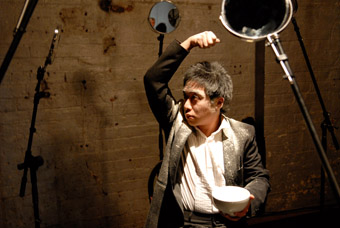
Teik-Kim Pok, Finale, The Pacitti Company, Live Works
photo Heidrun Löhr
Teik-Kim Pok, Finale, The Pacitti Company, Live Works
The overall experience for the audience of Finale was not a particularly coherent one, even if you knew the novel, and the big audience on the final night and the absence of crowd management meant that there was a high degree of luck involved in gaining an overview let alone encountering some of the work’s most potent images. But, I enjoyed what I witnessed, and the freedom to wander and select in a work of such scale was welcome. So too was the opportunity to reflect on the polished viscerality of the overall production—a kind of high church Anglican performance mode when compared with the ‘pagan Catholicism’ (to coin a Fiona McGregor phrase; p40) of Guillermo Gomez-Pena and La Pocha Nostra’s gritty collaborations with Sydney artists in 2001 and 2003.
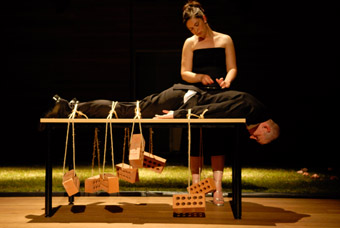
Finale, The Pacitti Company, Live Works
photo Heidrun Löhr
Finale, The Pacitti Company, Live Works
Nalina Wait’s Dual with collaborator Jane McKernan presented two idiosyncratic dancers at their most formal and abstract. It’s a well-produced work (lighting by Mark Mitchell) but the finely shaped duets and solos don’t add up at first viewing, although the ending, where McKernan confronts Wait with a cascade of furious gestures and moves, suggests a more dramatic reading—a dialogue and then a tussle perhaps between ways of being and dancing.
Helen Cole, Producer of Live Art and Dance at Bristol’s Arnolfini and artistic director of the Inbetween Time festival (collaborating closely with PS and Fiona Winning) sat us in the dark to listen to recordings of intimate recollections of performances of all kinds, from fairs, clubs, theatre, ceremonies and from diverse voices (audiences, curators, directors, performers) while fragments of light (Alex Bradley) appeared, grew and were redistributed around the theatre. Titled We See Fireworks, the work engenders a slightly eerie experience, being a very different kind of archive from the ones we usually expect of the arts, and so removed from the art of reviewing. As Cole writes, “Between the ghost of a memory and the knowledge that you were really there, we think this thing called theatre might just be in your head.”
parting thoughts
I had the pleasure of talking at length with Fiona Winning during her final days at Performance Space. The full transcript. We talked about her role as director and she described how it had changed over the years. Initially there was need to rebuild the confidence of the communities around Performance Space and among audiences after the organisation had been through a difficult period: “I was always interested in connecting dots between the temporary communities that build through making art and how to find more opportunities to build those communities. I think of it as a boiling pot and the bubbles that emerge are this energy that needs to exist and be released but it also needs to be held together. What I began to realise, not terribly long into the job, was that part of my role was to be responsive, but part of it was to be strategic and to really try to make sense of the bigger picture and to build opportunities for artists. So it was a mixture of advocacy, strategic planning and partnering, bringing our own projects as interventions or opportunities, again to build temporary communities that wouldn’t otherwise make themselves.”
As well as an emphasis on community Winning early on saw the need for greater intergenerational contact between artists: “part of that was about exchange but part of it was also about being aware of lineage because I think that’s a powerful and important thing. And it’s probably re-emerging. This is another moment when I think it’s deeply important again.” Another element in building Performance Space was to in turn build its residency program: “It was important to me and it was mostly intergenerational and it was actually really successful. Version 1.0 got one of those early residencies to make The Second Last Supper (2001), along with a number of other interesting groups.” Residencies proved useful for artists to use as leverage to get funding for their fees for what was “really invaluable research and development for which, of course, it’s really difficult to get funding.” Winning sees the residencies “as probably one of the most successful parts of the Performance Space program.”
With no capacity to buy work in itself, to be in fact a producer, Performance Space has for many years presented self-producing artists like Tess de Quincey and The opera Project in its curated performance programs and assisted them in every way possible. Now, Winning tells me, with great pleasure, a new model has been developed. “In the old days artists paid the rental and they got the box office and we created the context around it: the technical support, front of house and all that kind of stuff. We are now co-presenting in the sense that we offer the space, the front of house, a certain amount of tech support and we are partners in a 60/40 split of box office. So the risk is actually shared. But what’s changed most recently has come with the Presenter Program grants that the Theatre Board of the Australia Council has just given out. Performance Space received one of these, as did Arts House in Melbourne, PICA in Perth and a number of other organizations around the country. That’s $50,000 a year for three years just for artists’ fees. So that means that next year for the first time we’re actually completely presenting My Darling Patricia, Version 1.0 and Rosie Dennis. They’ll get their performance fees paid by us. It’s not a commission. It’s simply a presentation, but it means that the artists know what they’re getting paid. They don’t have to try and balance any books or cut any costs post-production. Partly that’s the Australia Council responding to something that I realised very early in my job, how difficult it is for artists to self-produce, self-present and make the work.”
Further on the producing front, Winning is inspired by a generation of younger artists like My Darling Patricia, Spat & Loogie, Brown Council, Janie Gibson, Post, Matthew Prest and others who are “makers first and foremost, but they’re also curators and producers. They’re so interested in the whole picture. And that’s very exciting because I think there are some artists who continue to see Performance Space as their main kind of place and I don’t think anybody can afford to do that, quite frankly. I think it’s important that Performance Space remains a home and hub but everyone needs to think a lot more rhizomatically than that and have relationships with the other partners, producers and presenters…There is a better national network than there ever has been for artists to tap into.” The DIY performance culture is also encouraged through Performance Space’s Night Time series of short works and its support for the Quick & Dirty queer performance seasons.
Winning says that making the most of the new home at CarriageWorks has been a challenge: “When you move to a place like CarriageWorks and you’re learning those physical spaces both technically and artistically and from the audience’s perspective, it takes time. I was fairly naïve…and naiveté is quite useful sometimes…We love those spaces, but there are sets of negotiations around everything.” Large-scale works, Tess De Quincey’s The Stirring and Joey Ruigrok van der Werven’s Volta (both 2007), along with LiveWorks, have been integral to PS’s growing mastery of the space.
Fiona Winning is a collaborative spirit. Initially she felt isolated when programming, but as Performance Space has grown across recent years, the organisation has been able to employ expert programmers across a range of forms. Former associate directors Blair French and Caitlin Newton-Broad initiated strong programs, as their successors Bec Dean and Rebecca Conroy are now doing, along with Rosalind Richards as dance producer. Winning says that “the integration of One Extra and ReelDance into the Performance Space program has also been important. We were very lucky to be able to support ReelDance—and now they’ve got Emerging Triennial funding.”
Despite her optimism about growing producer and presenter networks, the spirit of independence in a new generation of performance makers and the satisfaction entailed in being able to guarantee artists their fees, Winning worries about the future of the small to medium arts sector given challenges facing CarriageWorks and Performance Space. There’s the need “for the commercial side to bring in enough money to support CarriageWorks to (a) be able to run itself and some programs themselves and (b) be able to subsidise the small to medium sector…that’s their challenge and, therefore, our challenge because our destinies are somewhat intertwined.” A shift in Arts NSW policy away from project funding to program funding puts the onus on organisations to support individual artists and small companies, but without the additional funds to do so. Meanwhile, “federally, the Theatre Board has been moving towards putting more resources into presenters and producers but they still need the independent artists to bring the money for their projects with them. So on the one hand we’ve got this new big picture being presented by the Australia Council and it’s just simply not able to be matched at a State level.”
Winning is now moving on to theTime Place Space hybrid arts laboratory no. 6, which she’s co-curating with Sarah Miller and Teresa Crea in January-February 2009 in Brisbane. She feels herself “incredibly lucky” to have been Performance Space director, it’s helped define her vision: “I know what my passion is. I love programming. And I love working with artists through that trajectory of concept development, through to production and touring…So finding another context in which to be able to do that is going to be my greatest challenge.”
Performance Space, LiveWorks, Performance Space, CarriageWorks, Sydney, Aug 29-Sept 7
Read the full interview with Fiona Winning
RealTime issue #88 Dec-Jan 2008 pg. 34-35






